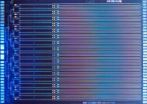(Press-News.org) Move over, touchpad screens: New research funded in part by the National Institutes of Health shows that it is possible to manipulate complex visual images on a computer screen using only the mind.
The study, published in Nature, found that when research subjects had their brains connected to a computer displaying two merged images, they could force the computer to display one of the images and discard the other. The signals transmitted from each subject's brain to the computer were derived from just a handful of brain cells.
"The subjects were able to use their thoughts to override the images they saw on the computer screen," said the study's lead author, Itzhak Fried, M.D., Ph.D., a professor of neurosurgery at the University of California, Los Angeles. The study was funded in part by the National Institute of Neurological Disorders and Stroke (NINDS), and the National Institute of Mental Health (NIMH), both part of NIH.
The study reflects progress in the development of brain-computer interfaces (BCIs), devices that allow people to control computers or other devices with their thoughts. BCIs hold promise for helping paralyzed individuals to communicate or control prosthetic limbs. But in this study, BCI technology was used mostly as a tool to understand how the brain processes information, and especially to understand how thoughts and decisions are shaped by the collective activity of single brain cells.
"This is a novel and elegant use of a brain-computer interface to explore how the brain directs attention and makes choices," said Debra Babcock, M.D., Ph.D., a program director at NINDS.
The study involved 12 people with epilepsy who had fine wires implanted in their brains to record seizure activity. Recordings like these are routinely used to locate areas of the brain that are responsible for seizures. In this study, the wires were inserted in the medial temporal lobe, a brain region important for memory and the ability to recognize complex images, including faces.
While the recordings from their brains were transmitted to a computer, the research subjects viewed two pictures superimposed on a computer screen, each picture showing a familiar object, place, animal or person. They were told to select one image as a target and to focus their thoughts on it until that image was fully visible and the other image faded away. The monitor was updated every one-tenth of one second based on the input from the brain recordings.
As a group, the subjects attempted this game nearly 900 times in total, and were able to force the monitor to display the target image in 70 percent of these attempts. Subjects tended to learn the task very quickly, and often were successful on the first try.
The brain recordings and the input to the computer were based on the activity of just four cells in the temporal lobe. Prior research has shown that individual cells in this part of the brain respond preferentially – firing impulses at a higher rate – to specific images. For instance, one cell in the temporal lobe might respond to seeing a picture of Marilyn Monroe, while another might respond to Michael Jackson. Both were among the celebrity faces used in the study.
Dr. Fried's team first identified four brain cells with preferences for celebrities or familiar objects, animals or landmarks, and then targeted the recording electrodes to those cells. The team found that when subjects played the image-switching game, their success appeared to depend on their ability to power up cells that preferred the target image and suppress cells that preferred the non-target image.
"The remarkable aspects of this study are that we can concentrate our attention to make a choice by modulating so few brain cells and that we can learn to control those cells very quickly," said Dr. Babcock.
Prior studies on BCIs have shown that it is possible to perform other tasks, such as controlling a computer cursor, with just a few brain cells. However, the task here was more complex and might have been expected to involve legions of cells in diverse brain areas needed for vision, attention, memory and decision-making.
INFORMATION:
Reference: Cerf M et al. "On-line, voluntary control of human temporal lobe neurons," Nature, October 28, 2010.
NINDS (www.ninds.nih.gov) is the nation's leading funder of research on the brain and nervous system. The NINDS mission is to reduce the burden of neurological disease – a burden borne by every age group, by every segment of society, by people all over the world.
The mission of the NIMH (www.nimh.nih.gov) is to transform the understanding and treatment of mental illnesses through basic and clinical research, paving the way for prevention, recovery and cure.
NIH — The Nation's Medical Research Agency — includes 27 Institutes and Centers and is a component of the U.S. Department of Health and Human Services. It is the primary federal agency for conducting and supporting basic, clinical and translational medical research, and it investigates the causes, treatments, and cures for both common and rare diseases. For more information about NIH and its programs, visit www.nih.gov.
END
Why do some of the one million people who sustain head injuries annually in United States experience a mysterious second wave of brain damage days after the initial injury — just when they appear to be recovering? Limited clinical trials using an innovative new device to monitor brain chemistry on a second-by-second basis are underway to answer that life-and-death question, according to an article in the current issue of Chemical & Engineering News (C&EN), ACS' weekly newsmagazine. Brain injury is the leading cause of death and disability worldwide.
C&EN Senior Editor ...
Scientists are calling for more research on the possibility that some supposedly healthful plant-based antioxidants — including those renowned for their apparent ability to prevent cancer — may actually aggravate or even cause cancer in some individuals. Their recommendation follows a study in which two such antioxidants — quercetin and ferulic acid — appeared to aggravate kidney cancer in severely diabetic laboratory rats. The study appears in ACS' bi-weekly Journal of Agricultural and Food Chemistry.
Kuan-Chou Chen, Robert Peng, and colleagues note that vegetables, ...
Extending its 26-year tradition of innovative quantum voltage standards, researchers at the National Institute of Standards and Technology (NIST) have begun shipping a new 10-volt standard to users around the world. The programmable system measures both direct current (DC) and alternating current (AC) voltages.
NIST AC/DC 10-volt standard chip.
The new 10-volt system* builds on a number of previous NIST inventions, from the initial 1-volt standard in 1984 through the 2006 unveiling of the world's first precision instrument for directly measuring AC voltages.** Because ...
Better psychological and spiritual support, improved planning of care and stronger relationships with physicians are necessary to improve end-of-life care in Canada, according to a study by a Queen's University professor.
"High quality end-of-life care should be the right of every Canadian," says professor of Medicine and Epidemiology Daren Heyland, who is also a researcher at Kingston General Hospital. "But it's not always happening. We know from international studies that Canada ranks ninth in the world in terms of quality of care provided at the end of life."
The study, ...
Taking the first steps of what would be a major historical advance in the science of measurement, the National Institute of Standards and Technology (NIST) is participating in a worldwide effort to recommend major revisions to the International System of Units (SI), the modern metric system that is the basis of global measurements in commerce, science and other aspects of everyday life. The new SI, which would be based on seven constants of nature, would enable researchers around the world to express the results of measurements at new levels of consistency and accuracy.
The ...
Cockroaches can skitter through a crowded under-the-sink cabinet, eluding capture or worse, making the insects a model for rescue robots that would creep through the debris of disaster in search of survivors.
But learning how they use all six legs at the same time to walk, run and turn has been a difficult and time-consuming task. Until now.
Using a pair of high-speed cameras and a custom computer program, researchers at Case Western Reserve University are able to simultaneously extract three-dimensional movement of a cockroach's 26 leg joints. They report their findings ...
Texas A&M University is one of 10 international partners involved in the global conservation study and subsequent scientific paper, "The Impact of Conservation on the Status of the World's Vertebrates," that is scheduled to be published in Science, the academic journal of the American Association for the Advancement of Science.
Dr. Thomas E. Lacher, Jr., Texas A&M University's wildlife and fisheries sciences department head at College Station, Texas and a coauthor, said the report reviews the current status of thousands of species in light of the 2010 target of the Convention ...
Two micro-satellites originally launched into Earth's orbit in 2007 by NASA have been redirected by University of California, Berkeley, scientists toward new orbits around the moon, extending study of the earth and moon's interaction with the solar wind.
The second of the two probes settled into a temporary "Lagrange-point" orbit on Friday, Oct. 22, inaugurating science operations for a new mission dubbed ARTEMIS – Acceleration, Reconnection, Turbulence, and Electrodynamics of the Moon's Interaction with the Sun.
Lagrange points are places where the gravity of Earth ...
Researchers at North Carolina State University have found that the overproduction of a key protein in stem cells causes those stem cells to form cancerous tumors. Their work may lead to new treatments for a variety of cancers.
Dr. Jon Horowitz, associate professor of molecular biomedical sciences, and a team of NC State researchers looked at the protein SP2, which regulates the activity of other genes. They knew that elevated amounts of SP2 had been observed in human prostate-cancer patients, and that these levels only increased as the tumors became more dangerous. They ...
DURHAM, N.C. – A doubling of abnormally wet or dry summer weather in the southeastern United States in recent decades has come from an intensification of the summertime North Atlantic Subtropical High (NASH), or "Bermuda High."
And that intensification appears to be coming from global warming, according to a new analysis by a Duke University-led team of climate scientists.
The NASH is an area of high pressure that forms each summer near Bermuda, where its powerful surface center helps steer Atlantic hurricanes and plays a major role in shaping weather in the eastern ...


